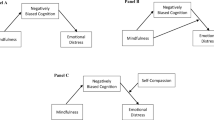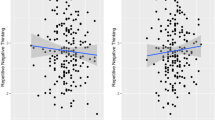Abstract
Individuals with negative cognitive style are at high risk for depressive disorders; however, the mechanisms linking cognitive vulnerability to depression are not fully understood. Here, we use an attentional blink task to test whether stimuli associated with negative attributions are especially salient to individuals with high negative cognitive style. We found that individuals high in negative cognitive style were able to attend to negative attribution words during a period of time when attentional resources would ordinarily be depleted. These individuals were not more likely than those with low or moderate negative cognitive style to detect neutral and negative non-self-relevant words during this period. These data suggest that cognitive style modulates the saliency of material that is relevant to negative attributions, and these alterations in information processing may link cognitive style to development of depression.


Similar content being viewed by others
References
Abramson, L. Y., Alloy, L. B., Hankin, B. L., Haeffel, G. J., MacCoon, D. L., & Gibb, B. E. (2002). Cognitive vulnerability-stress models of depression in a self-regulatory and psychobiological context. In I. H. Gotlib & C. L. Hammen (Eds.), Handbook of depression (2nd ed., pp. 268–294). New York: The Guilford Press.
Abramson, L. Y., Metalsky, G. I., & Alloy, L. B. (1989). Hopelessness depression: A theory based subtype of depression. Psychological Review, 96, 358–372.
Alloy, L. B., Abramson, L. Y., Hogan, M. E., Whitehouse, W. G., Rose, D. T., Robinson, M. S., et al. (2000). The Temple—Wisconsin Cognitive Vulnerability to Depression Project: Lifetime history of Axis I psychopathology in individuals at high and low cognitive risk for depression. Journal of Abnormal Psychology, 109, 403–418.
Alloy, L. B., Abramson, L. Y., Murray, L. A., Whitehouse, W. G., & Hogan, M. E. (1997). Self-referent information-processing in individuals at high and low cognitive risk for depression. Cognition and Emotion, 11, 539–568.
Anderson, A. K. (2005). Affective influences on the attentional dynamics supporting awareness. Journal of Experimental Psychology, 134, 258–281.
Beck, A. T., Ward, C., & Mendelson, M. (1961). Beck depression inventory (BDI). Archives of General Psychiatry, 4, 561–571.
Bradley, M. M., & Lang, P. J. (1999). Affective norms for English words (ANEW). Gainesville, FL: The NIMH Center for the Study of Emotion and Attention, University of Florida.
Chun, M. M., & Potter, M. C. (1995). A two-stage model for multiple target detection in rapid serial visual presentation. Journal of Experimental Psychology: Human Perception and Performance, 21, 109–127.
Eizenman, M., Yu, L. H., Grupp, L., Eizenman, E., Ellenbogen, M., Gemar, M., et al. (2003). A naturalistic visual scanning approach to assess selective attention in major depressive disorder. Psychiatry Research, 118(2), 117–128.
Fox, E., Russo, R., & Georgiou, G. A. (2005). Anxiety modulates the degree of attentive resources required to process emotional faces. Cognitive, Affective, & Behavioral Neuroscience, 5, 396–404.
Gotlib, I. H., Krasnoperova, E., Yue, D. N., & Joormann, J. (2004). Attentional biases for negative interpersonal stimuli in clinical depression. Journal of Abnormal Psychology, 113(1), 121–135.
Gross, J. J., & Thompson, R. A. (2007). Emotion regulation: Conceptual foundations. In J. J. Gross (Ed.), Handbook of emotion regulation (pp. 3–24). New York, NY, US: Guilford Press.
Haeffel, G. J., Gibb, B. E., Metalsky, G. I., Alloy, L. B., Abramson, L. Y., Hankin, B. L., et al. (2008). Measuring cognitive vulnerability to depression: Development and validation of the cognitive style questionnaire. Clinical Psychology Review, 28, 824–836.
Isaacowitz, D. M., Toner, K., & Neupert, D. (2009). Use of gaze for real-time mood regulation: Effects of age and attentional functioning. Psychology and Aging, 24, 989–994.
Keil, A., & Ihssen, N. (2004). Identification facilitation for emotionally arousing verbs during the attentional blink. Emotion, 1, 23–35.
McCabe, S. B., Gotlib, I. H., & Martin, R. A. (2000). Cognitive vulnerability for depression: Deployment of attention as a function of history of depression and current mood state. Cognitive Therapy and Research, 24, 427–444.
Mezulis, A. M., Abramson, L. Y., Hyde, J. S., & Hankin, B. L. (2004). Is there a universal positivity bias in attributions? A meta-analytic review of individual, developmental, and cultural differences in the self-serving attributional bias. Psychological Bulletin, 130, 711–747.
Romens, S. E., Abramson, L. Y., & Alloy, L. B. (2009). High and low cognitive risk for depression: Stability from late adolescence to early adulthood. Cognitive Therapy and Research, 33, 480–498.
Rothbart, M. K., Posner, M. I., & Kieras, J. (2006). Temperament, attention, and the development of self-regulation. In K. McCartney, D. Phillips, & M. A. Malden (Eds.), Blackwell handbook of early childhood development (pp. 338–357). Oxford: Blackwell.
Shapiro, K. L., Arnell, K. M., & Raymond, J. E. (1997). The attentional blink. Trends in Cognitive Sciences, 1, 291–296.
Watson, D., Clark, L. A., & Tellegen, A. (1988). Development and validation of brief measures of positive and negative affect: The PANAS scales. Journal of Personality and Social Psychology, 54, 1063–1070.
Acknowledgments
This study was supported by a Collaborative Research Award from the University of Wisconsin Department of Psychology (SR) and by the US National Institute of Health (SP).
Author information
Authors and Affiliations
Corresponding author
Rights and permissions
About this article
Cite this article
Romens, S.E., MacCoon, D.G., Abramson, L.Y. et al. Cognitive Style Moderates Attention to Attribution-Relevant Stimuli. Cogn Ther Res 35, 134–141 (2011). https://doi.org/10.1007/s10608-010-9345-8
Published:
Issue Date:
DOI: https://doi.org/10.1007/s10608-010-9345-8




